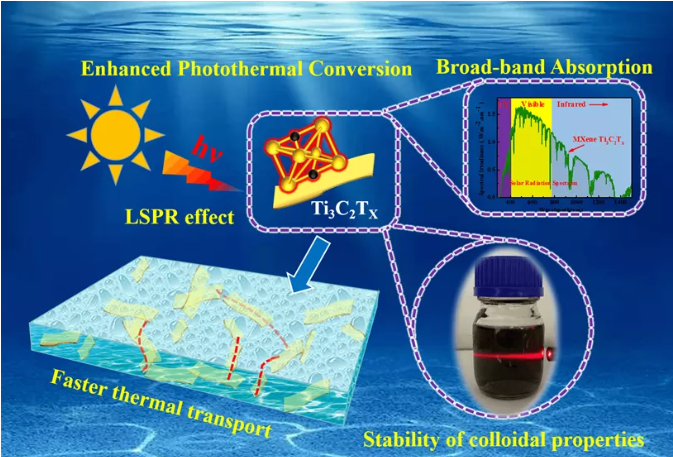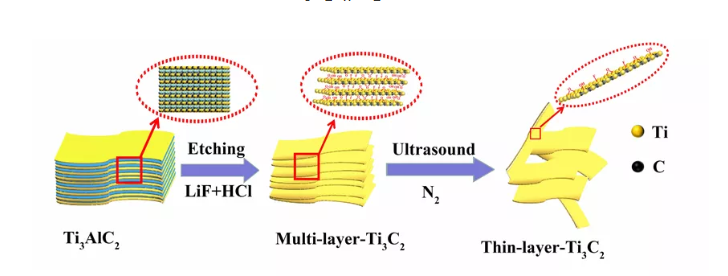
hotline:
17715390137
Tel/Wechat:
18101240246 (Technology)
0512-68565571
Email:mxenes@163.com (Sales Engineer)bkxc.bonnie@gmail.com
Scan the code to follow or search the official account on WeChat:
2D Materials Fronrier After paying attention,
click on the lower right corner to contact us,
Enter enterprise WeChat.
Professional Services Online

Author:
Yu Wei Shanghai Second Polytechnic University
Yue Yanan Wuhan University
Two-dimensional transition metal carbon (nitrogen) compound (Mxene) is a new type of two-dimensional material since YuryGogotsi et al. discovered titanium carbide (Ti3C2Tx) in 2011. Because of its excellent high electrical conductivity, high thermal conductivity, electromagnetic wave absorption ability and other properties, it has been widely used in electromagnetic shielding, super capacitors, catalysis and other fields. Recently, MXene has been proven to have super light absorption capacity, and its solar spectral response range can be extended to the near infrared (NIR) region, showing great application prospects in solar thermal energy storage systems. A large number of studies have reported the photothermal conversion effect of MXene, but people still lack a thorough understanding of its photothermal conversion mechanism as a light absorber.
Recently, the team of Professor Yu Wei of Shanghai Second Polytechnic University and Professor Yue Yanan of Wuhan University have prepared multilayer MXene (m-Ti3C2Tx) and graphene-like two-dimensional thin layer MXene (t-Ti3C2Tx) using the etching-stripping method. Nanosheets, obtained Ti3C2Tx-H2O nanofluid with super stable colloidal properties, and used it as the working fluid of direct solar collectors (DASCs) to study its photothermal conversion performance and mechanism. The results show that the thin-layer Ti3C2Tx nanofluid exhibits a high photothermal conversion performance. When the mass fraction is 0.02%, the maximum photothermal conversion efficiency reaches 91.9%. At the same time, a numerical model was established to investigate the conversion of radiant energy from the micro-nano scale. It was found that the strong local surface plasmon resonance (LSPR) effect of the thin-layer MXene Ti3C2Tx enhanced the light absorption performance of the Ti3C2Tx-H2O nanofluid. In addition, the coupling effect and the shape of Ti3C2Tx particles also play an important role in the absorption and conversion of light and heat. The photothermal conversion mechanism is shown in Figure 1:

Figure 1 The photothermal conversion mechanism of Ti3C2Tx-H2O

Figure 2 Schematic diagram of the preparation process of MXene Ti3C2Tx

Figure 3 (a) Ti3AlC2, m-Ti3C2Tx and t-Ti3C2Tx absorbance; (b) Ti3AlC2, m-Ti3C2Tx and t-Ti3C2Tx with a mass fraction of 0.05wt% nanofluid placed at 808nm for 15 days transmittance change (the illustration is t -Ti3C2Tx-H2O nanofluid Tyndall effect)

It can be seen from Figure 3 that Ti3C2Tx-H2O has a wide light response range that can be extended to the near-infrared (NIR) region and the light transmittance does not increase after 15 days of exposure, indicating that the Ti3C2Tx-H2O nanofluid we prepared has higher stability and It exhibits the typical Tyndall effect of colloids, which breaks through the limitation of poor stability of nanofluids in the field of solar heat utilization and prone to agglomeration and precipitation.
Figure 4 (a) Thermal imaging at temperature equilibrium; (b) Photothermal conversion efficiency; (c) Comparison of photothermal conversion efficiency of nanofluids with the same mass fraction (0.02wt%) of different nanoparticles
It can be seen from Figure 4 that Ti3C2Tx-H2O has a high photothermal conversion performance. When the mass fraction is 0.02%, the maximum photothermal conversion efficiency reaches 91.9%, which is higher than the one prepared by our team with good photothermal conversion effect. Light and heat work materials.

Figure 5 (a) Ti3C2Tx simulation model structure; (b) Absorbance simulation results; (c) The upper surface light field enhancement contribution of thin Ti3C2Tx; (d) The upper surface light field enhancement contribution of multilayer Ti3C2Tx
As can be seen in Figure 5, the upper surface light field enhancement contribution of the thin Ti3C2Tx is up to 3.1057, and its enhancement contribution is 2 times higher than that of the multilayer Ti3C2Tx (Mmax = 1.5689). That is, the LSPR effect of Ti3C2Tx is as susceptible to the influence of structural geometric parameters as other precious metal nanoparticles Au and Ag. The better photothermal performance of the thin MXene Ti3C2Tx is mainly due to its strong local surface plasmon resonance (LSPR) effect, which can be improved by reducing the thickness.
The above results were published in SolarEnergy Materials and Solar Cells. Wang Debing, a graduate student in the Faculty of Engineering of Shanghai Second Polytechnic University, and Fang Yuxin, a graduate student of Wuhan University, are the co-first authors. Professor Yu Wei from the Faculty of Engineering of Shanghai Second Polytechnic University and Professor Yue Yanan of Wuhan University are the co-corresponding authors.
Paper information:
Significantsolar energy absorption of MXene Ti3C2Tx nanofluids via localized surface plasmon resonance, Solar Energy Materials & Solar Cells 220 (2021) 110850, https://doi.org/10.1016/j.solmat.2020.110850
Information source: micro-nano scale heat transfer
This information is from the Internet for academic exchanges. If there is any infringement, please contact us and delete it immediately

| Reminder: Beijing Beike New Material Technology Co., Ltd. supplies products only for scientific research, not for humans |
| All rights reserved © 2019 beijing beike new material Technology Co., Ltd 京ICP备16054715-2号 |